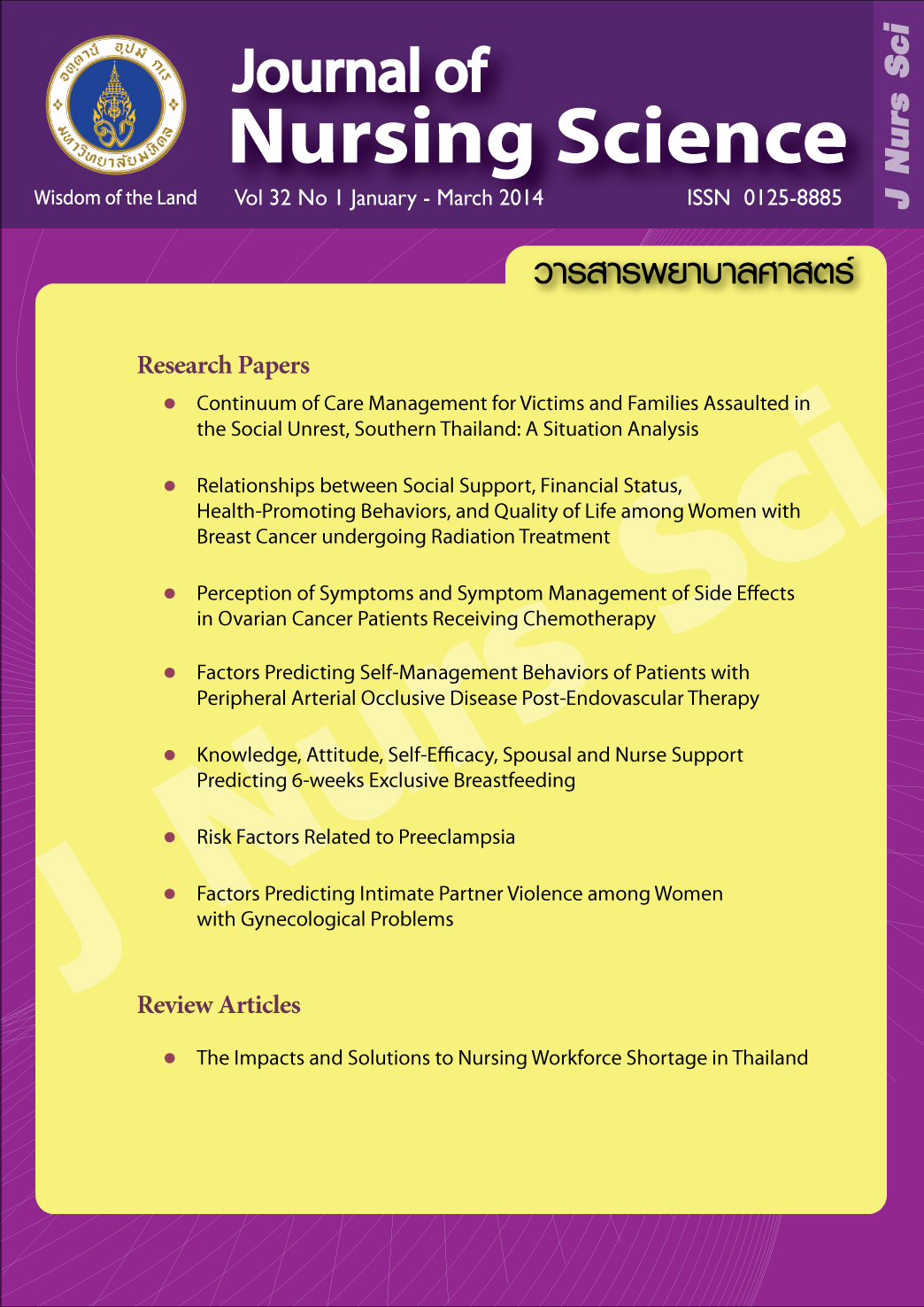Risk Factors Related to Preeclampsia
Main Article Content
Abstract
Purpose: To investigate the relationship between pre-pregnancy body mass index, calcium intake, fiber intake, gestational weight gain, and mean arterial pressure in the second trimester and preeclampsia.
Design: A case-control study.
Methods: The study samples were postpartum mothers who sought services at King Chulalongkorn Memorial Hospital, the Thai Red Cross Society, and at Siriraj Hospital who had records of prenatal care at the hospitals. The study subjects were divided into two groups. The case group consisted of 75 subjects who were diagnosed with preeclampsia during pregnancy; the control group was composed of 150 subjects who had normal pregnancy. Data were collected by demographic characteristics questionnaire and frequency of food intake questionnaire. Data were analyzed using chi-square test and multiple logistic regression analysis.
Main findings: In different values of each variable, pre-pregnancy body mass index, calcium intake, fiber intake, gestational weight gain, and mean arterial pressure in the second trimester were significantly associated with developing preeclampsia (p < .05). It also found that pregnant women who had mean arterial pressure in the second trimester ≥ 90 mmHg have the risk of preeclampsia 10.537 times more than pregnant women who had mean arterial pressure < 90 mmHg (p < .05). Those who had calcium intake ≥ 800 mg/day and fiber intake ≥ 25 gm/day had decreased risk of preeclampsia for 0.368 and 0.083 times of those pregnant women who had less calcium and fiber intake (p < .05).
Conclusion and recommendations: Screening and monitoring risks of preeclampsia should be concerned about mean arterial pressure, pre-pregnancy body mass index, and weight gain in the second trimester. Pregnant women at risk for preeclampsia should be advised to have diet with high calcium and high fiber.
Keywords: calcium, fibers, mean arterial pressure, preeclampsia
ปัจจัยเสี่ยงที่มีความสัมพันธ์กับภาวะความดันโลหิตสูงขณะตั้งครรภ์
บทคัดย่อ
วัตถุประสงค์: เพื่อศึกษาความสัมพันธ์ระหว่างดัชนีมวลกายก่อนการตั้งครรภ์ ปริมาณแคลเซียมในการบริโภค ปริมาณใยอาหารในการบริโภค การเพิ่มของน้ำหนักระหว่างตั้งครรภ์ และค่าความดันเลือดแดงเฉลี่ยในไตรมาสสองกับการเกิดภาวะความดันโลหิตสูงขณะตั้งครรภ์
รูปแบบการวิจัย: Case-control study
วิธีดำเนินการวิจัย: กลุ่มตัวอย่าง คือ สตรีระยะหลังคลอดบุตรที่มารับบริการในโรงพยาบาลจุฬาลงกรณ์ สภากาชาดไทย และโรงพยาบาลศิริราช ซึ่งมีประวัติการฝากครรภ์ โดยแบ่งเป็น 2 กลุ่ม ได้แก่ กลุ่มศึกษา เป็นสตรีที่ได้รับการวินิจฉัยว่ามีภาวะความดันโลหิตสูงขณะตั้งครรภ์จำนวน 75 ราย และกลุ่มเปรียบเทียบ เป็นกลุ่มสตรีตั้งครรภ์ปกติจำนวน 150 ราย เก็บข้อมูลโดยใช้แบบบันทึกข้อมูลส่วนบุคคล และแบบสัมภาษณ์ความถี่ในการรับประทานอาหาร วิเคราะห์ข้อมูลโดยสถิติไคสแควร์ และสถิติถดถอยโลจิสติกเชิงพหุคูณ
ผลการวิจัย: ในแต่ละตัวแปรที่มีค่าแตกต่างกัน ดัชนีมวลกายก่อนการตั้งครรภ์ ปริมาณแคลเซียมในการบริโภคปริมาณใยอาหารในการบริโภค การเพิ่มของน้ำหนักระหว่างตั้งครรภ์ และค่าความดันเลือดแดงเฉลี่ยในไตรมาสที่สอง มีความสัมพันธ์กับการเกิดภาวะความดันโลหิตสูงขณะตั้งครรภ์อย่างมีนัยสำคัญทางสถิติ (p < .05) โดยพบว่าสตรีตั้งครรภ์ที่มีค่าความดันหลอดเลือดแดงเฉลี่ยในไตรมาสที่สอง ≥ 90 มิลลิเมตรปรอท มีความเสี่ยงที่จะเกิดภาวะความดันโลหิตสูงขณะตั้งครรภ์มากกว่าเป็น 10.537 เท่าของกลุ่มที่มีค่าความดันหลอดเลือดแดงเฉลี่ย < 90 มิลลิเมตรปรอท (p < .05) และสตรีตั้งครรภ์ที่บริโภคแคลเซียม ≥ 800 มิลลิกรัมต่อวัน และบริโภคใยอาหาร ≥ 25 กรัมต่อวัน มีโอกาสเสี่ยงที่จะเกิดภาวะความดันโลหิตสูงขณะตั้งครรภ์เป็น 0.368 และ 0.083 เท่าของสตรีที่ได้รับสารอาหารดังกล่าวในปริมาณน้อยกว่า (p < .05)
สรุปและข้อเสนอแนะ: การคัดกรองและติดตามความเสี่ยงต่อการเกิดภาวะความดันโลหิตสูงขณะตั้งครรภ์ ควรคำนึงถึงค่าความดันหลอดเลือดแดงเฉลี่ย ค่าดัชนีมวลกายก่อนการตั้งครรภ์ และการเพิ่มของน้ำหนักในไตรมาสที่สอง สตรีตั้งครรภ์ที่มีภาวะเสี่ยงต่อการเกิดความดันโลหิตสูงขณะตั้งครรภ์ควรได้รับคำแนะนำเกี่ยวกับการรับประทานอาหารที่มีปริมาณแคลเซียมและใยอาหารสูง
คำสำคัญ: แคลเซียม ใยอาหาร ค่าความดันเลือดแดงเฉลี่ย ภาวะความดันโลหิตสูงขณะตั้งครรภ์
Article Details
Copyright Notice: Nursing Science Journal of Thailand has exclusive rights to publish and distribute the manuscript and all contents therein. Without the journal’s permission, the dissemination of the manuscript in another journal or online, and the reproduction of the manuscript for non-educational purpose are prohibited.

Disclaimer: The opinion expressed and figures provided in this journal, NSJT, are the sole responsibility of the authors. The editorial board bears no responsibility in this regard.


